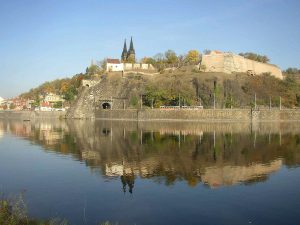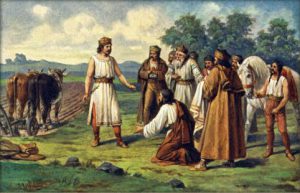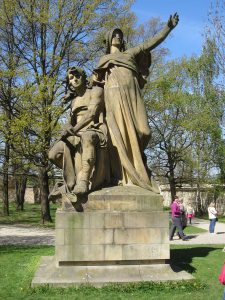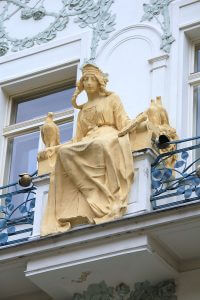
The Nation in the Wake of the Gods (5.
 07. 02. 2017
07. 02. 2017

The old rumors of Czech and Moravian countries
Much older, probably dating back to the period of the "Hallstatt era," is the story of a fiery bull, referring to the Býčí skála cave in the Moravian Karst. In this cave was one of the most important shrines of that time, which served both for the inauguration of the king or the prince of the Celts, and was the place of the cult burial of the dead king by the iron.
The sanctuary itself was dedicated to the dreaded divine oracle and woodcutter Esu, who often appeared here as a white or golden bull. There was also a sacred forge in which the Druid-Smith smashed the sword, the dagger, the helmet and the armor for the new King in an ancient manner, but on the contrary, the dead King removed the armor and ritually destroyed it. Possibly there were also funerals by the druids and the ashes of the dead surrendered to forests, meadows and streams. The Celts, like the Aryans, believed that death was only "the center of a long life," which opens the gates of new knowledge.
The body boxes did not weigh the Celts, and therefore did not pay much attention to their own funeral ceremony and ash storage. The ash should return as quickly as possible from where he came from - Nature. The Shrine in the Bull Rock has been associated with a marvelous reputation, which has survived in the various modified and deformed forms among the people there today.
The king of the Celts settled in Moravia for many centuries / perhaps had the name Borigiorix / was old and ill. The gods gave him a sign of impending death. King Borigiorix was very concerned about the future of his people. He had two sleepy daughters, an older Princess Gyrtas and a younger, barely grown child named Diurga. They no longer had a mother because she died in childbirth of her youngest daughter. The king knew well that the state could hold only a determined and brave man against the northern invaders, who would become the husband of Gyrtas and the king of the Moravian Celts.
Gyrtas was a renowned beauty, and was enraged by many valiant young warriors and wise men of mature age. There were two suitors between this suite. The first was the young prince of the king of the Western Celtic Urien, and the other was Prince of the Eastern Celtic Dordorix. Urien was one of the chief commanders of King Borigiorix and won many valuable victories for his army. He loved Gyrtas deeply, and she seemed to find herself more and more affectionate.
It did not like Prince Dordorix, who was very rich and militarily strong, but he was a man of crude and unrelenting soldiers. In addition, he was pleased with the many pleasures offered by the mighty man of that time. The wise king saw well that Dordorix was interested primarily in his empire and the royal treasure, whereas Gyrtas was merely a burden to it. Death time approached, and the king called the supreme druid and told him his decision that Urien would be the new king and husband of Gyrtas, and his declaration of the king would be made immediately after the funeral.
When the king died a few days later, the main druid announced his decision to all subjects. Only Dordorix was angry and said he would settle his right with the sword, then moved away. After three days, they brought the dead king at the head of the funeral procession to the sanctuary, and the burial car was covered with wood from the sacred trees. The Druid Blacksmith took King Borigiorix's sword, dagger, helmet and shield, and destroyed them in the sacred forge, as prescribed by the ancient law. The Druid boundary with the royal car ignited, and the Druid-High Priest approached the blessings of the marriage of Gyrtas and Urien, and to the introductory part of the mystery of the declaration of the new King.
As soon as the sacred sword for the new king was handed over to the altar by the sacred sword of Gyrtas, the rider rushed wildly into the shrine with a sword waving wildly, accompanied by several gunmen. It was none other than Dordorix. When he saw it coming late, his fury darkened the last remnants of humanity and justice. With his sword, he cut off both young arms of his young wife, Gyrtas, carrying a sacred sword for her husband and resting on the altar. Urien, who was unarmed to try to protect his beloved Gyrtas by the body, was one of the soldiers pierced, and then Gyrtas's second head broke. A horrible cut, in which all the girls from the procession and the druids were slaughtered, broke out.
The noise of burning burial boundaries and the desperate cries of the murdered were interrupted by a thunderous thunder, accompanied by a blinding fire surrounding the reaping golden bull - Esua. The bull Esus screamed terribly over the heathen of his favorite sanctuary. Then a large stone loosened from the ceiling and then crushed Dordorix's head. Not even his soldiers escaped and were covered with a stone avalanche that covered the entrance to the sanctuary.
Twice a year, on the anniversary of the tragedy and on the day of Samain, a procession of young women and old men in white emerges from the Bull Rock Cave, bypassing the plain and returning with a morning trumpet as he bows to a fiery bull standing motionless on a rock plateau. over the cave. When the procession enters the cave, a great glow appears, followed by a desperate call and cries of pain. Legend has it that the ghosts will calm down when a pure girl in a shrine places a golden crown on her lover's head and promises each other a kiss. Thus the ceremony will be completed and the god Esus will forget the ancient insult. I have heard that a wreath of blooming dandelions is enough instead of a golden crown, but the love of young people must be true and deep.
The third of the legends is the oldest and is probably related to the arrival of Celts in Bohemia, sometimes around 8. century BC The legend, or rather the myth, is strange and it is possible to see the distinct Indo-European elements. It relates to Vyšehrad and includes the prophecies of the times of the future. According to the ancient tradition, two very important shrines, connected with the cult of the Great Mother (Magna Mater), existed in the Czech and Moravian regions.
It was a sanctuary at Vyšehrad and a sanctuary on the top of Hostýn. The same symbol of black or dark blue-haired woman standing on the reverse moon and surrounded by the constellation of twelve stars is attached to both. The meaning of this symbol is not yet capable of decrypting, but rather that it has been carefully covered by the Catholic Marian cult.
The very name "Vysehrad" is, according to the indications, younger than the existence of Vyšehrad nemethon, but it also has a Celtic root. The original name of the sanctuary is obviously Indo-European, or perhaps Prologuetic: "Pragalbha" or "Pragaalbha". Indo-European tribe "albh" can be understood as "pure, white or holy". The word "praga" or root "prag" is probably derived from the Indo-European roots "pragaja", which is probably a "meeting". The whole meaning of the ancient name of Vyšehrad nemethon can therefore be understood as a "meeting of pure", which can be interpreted as a "Meeting of the Gods".
I think that the name of our capital city is here. The high age of the tradition is probably the pre-Hellenistic origin of the sanctuary and hence the beginnings of Prague. Originally there was probably no city, but only sanctuaries with a small settlement of priests and staff designed to serve and protect them. Nemethon was surrounded by a powerful sacred spring, which was to be erected on the top of the Vysehrad Rock, perhaps in the places of today's Slavín or in its immediate vicinity. The spring was captured in several tanks designed to cleanse priests' baths before worship, but some also served to treat sick and injured people. The Celts gave the source the name Isar or Iser, and the old Czechs changed it to "Jizerka". This spring existed in the days of Princess Libuše, who often carried out cleansing baths in the sacred water tank with his companions. Here, in fact, she was known as "Libus's Bath", and not at the foot of Vyšehrad by the Vltava river. Such an introduction to the Vyšehrad legend.
In ancient times, when the Great Mother populated the Earth with her children, she came once in a blessed state into a beautiful country full of flowers, scent and bird singing, lying between the high mountains that our ancestors named Sudetes and Gabrett. Unavena stopped to rest at the sacred spring on a black rock above the Foldah River.
The dazzling fragrance of the flowering trees and the beating of the Nightingales fell asleep, and in her sleep she brought a beautiful blonde child into the world. She bathed it in the sacred spring, and put it in the rainbow glowing golden cradle that the black rock released. The great Mother then prophesied that when a boy arrives, he establishes a powerful and respectful northern nation. When the time is fulfilled, the descendants of this nation return from two sides, from the sun of the east and from the sun in the west, and meet at that place.
From them, the people are born, and it is determined to know many miseries and misfortunes before they reach such spiritual power that the bees of many peoples of the earth can go. Then a young king will be born of this people who will bring peace to all the people on Earth and the light of knowledge. This is how the New Golden Age of Humankind will begin to unfold. The rainbow golden cradle, which has disappeared between them, reappears at the birth of the king, and rearing it as the Great Mother has long determined. When the King arrives and takes the government, the cradle changes into the rainbow golden throne, which the young King will live with along with the gods who descend at that time on Earth.
In one of the Greek books of the prophecy of Sibyl, a verdict was written, according to which, before the end of the Iron Age, a young man who would become a king appeared in one country behind the northern mountains. It stops wars and enforces universal peace on Earth. The city and nation surrounding this king will become the spiritual center of humanity in the coming Golden Age. The prophecy of Vyšehrad and Sibylla seems to point at one point. Something remarkable begins to vaguely resemble.
Many Czechs intimately know the beautiful legend of Přemysl and Libuše, which is actually the myth of the founding of the Czech state and the Přemyslid family, ruling for many centuries in Bohemia and Moravia. In a systemic and analogous analysis of this reputation, however, I came across a number of indicia that suggest a much deeper meaning than has been understood so far.
Already at the time of the arrival of the Nysa tribes, there was a school in Budca, where the descendants of the Celtic administrative and military nobility were educated under the direction of the designated druids. Eventually, this school, or rather the school, was also a collection of children of nobility, and so the young Nyss and Celts grew and studied together, as girls as girls. Approximately in the second half of 7. century CE was led by this school of Celtic high priest among all renowned and respected.
At that time, it was clear to many wise men that it was necessary to put one chief in the head of the tribes to lead, judge and teach them. By the general will of the people, the high priest of the noblemen's school in Budch, named Krokan or Krakan, who until now has been preserved in the form of "Step", was entrusted with this function. As he says, he had three daughters: Kazi / Kasin, Kasan /, Tetu / Tetas, Teten / and Libus / Liban, Libes /.
All three of them were pupils of the school of Buddhism, which was also attended by the first-born son of Lemus, the first-born son of Přemysl, staying at Stadice. As it is already among the youth, the Celtic drudge of Lebanon (Libuše) and Přemysl from the family of the Lemus nyus are found in it. At the end of the school Lebanon and Přemysl frequently visited each other and prepared a wedding. This complicates the "political" development in Bohemia. Krakan (Step) dies and hands the reins of government to the hands of his eldest daughter Lebanon.
This was not the happiest solution, for Lebanon, a more druid than the princess and ruler of the Nyss, did not have the rather hard hand needed to handle the men. Not so, Lebanon combines the pleasant with the useful and suggests a gathering of rulers for Prince Přemysl to treat him as a husband. The proposal is accepted for both sides and Lebanon sends a message to Přemysl with the offer of the princely table.
What's next is well known. The message comes in the footsteps of Lebanon's horse to Přemysl, who is just shaking his field. Now we are again struck by some strange indications. Above all, it is unlikely that the house governor will be in his own hands to plow the field, that is enough of other hands in the family. Kosmas knew that he was horses or bulls in Bohemia in his time.
The use of bulls was too risky for their difficult manageability. However, if the ruler had his field, the use of the bulls would be under his level and the use of horses would be in place. But the legend does not speak of horses. The Celtic legends connect princes and kings exclusively with bulls, as weighted and worshiped animals connecting the king and the gods. In addition, the cult of a bull or cow has an ancient tradition not only in the Celtic world, but also in the ancient Egyptians, the Aryans, and the Germans. According to ancient traditions, the incoming king had to take up at least one furrow in the sacred field to prove his royal qualifications.
The more hell he took, the more he received it. But he always had a bull in the breeze, so that plowing was really a royal task. As the bull personified the cosmic powers governing the Earth, the king, by mastering a plowing bull, gave his subjects guarantees that he was able to rule well in the wild. I am therefore convinced that Přemysl also had a bull in the breeze, who, after being sacked, left and disappeared in a rock at Stadik.
By the way, Celtic nemethon was not a static rock? The tradition of royal orbits with bulls is more common in peoples deriving their origin from the Aryans. Meanwhile, the Mediterranean and West European nations have also maintained an ancient tradition of bull and bull matches. They have developed famous bullfights, popular in western coastal France and Spain, but the origin is apparently associated with the civilization of a nation named after their mythical king - the Minoans.
The tradition of bullfights and bulls had the desire of the man to approach the most powerful gods, but this was not possible unless they overcame the phenomenon of a bull standing between man and gods. In the bullfighting of the priests, they carefully examined whether the bulls walked firmly in the wake, whether they were insecure or straddling.
The very favorable sign that testified of the future favor of the gods was a tame and obedient behavior, with the bulls standing on all four legs. In Premyslid reputation, the bulls behave exactly, though it is not stressed. This sign was much more important than the other phases of Premysl. The behavior of the Premysl bulls indicated that the future powers of the future Sovereign, especially the future nation, are in favor of the cosmic forces.
I will not go deeper into the interpretation of the Přemyslid reputation, because it was so many and better done. Perhaps I can only remind you that the disappearance of bulls in the Stadical Rock has a common thread with the Blanic Knights, namely that both remain to be helped by the side of a new nation (even if they hide) in the event of a serious threat to its existence. With the departure of bulls, the reputation adds that when the nation is the worst, the bulls will come again from the rock, and the future sovereign from the simple people will lead them again.
This nation will rise to the famous victory, after which a lasting peace will come. It is possible to observe a certain parallel with the Vyšehrad legend and the prophecy of Sibyl. For us, however, the most important is a clear message about the legitimacy of a new nation, which comes from the combination of Czech (ny) and Celtic parents. The pro-Jewish legend is intimately related to the prophecy of Lebanon / Libuše /, which comes after the wedding ceremony and the handover to the new prince.
There are a number of different versions of this prophecy, because there is no single original written source. It is a little known fact that both the Celts and the Aryans have strictly refused written or graphic records, and all communications of traditions and ethical principles have been based exclusively on chain oral submissions. Therefore, the Aryan Vedas have been recorded in writing relatively recently, even though their age is in fact at least 4000 years.
Lebanon and her sisters were among the most respected priestess-drusades of Vyšehrad nemethon. She excelled herself in wisdom and ability to see things and do things to others. In his vision of the future of the nation, Lebanon says, "What is going on in the future, and what is hidden in the depths of the earth, my gods will now speak to me. I see the site seemingly sacred, around the city, and glory like the plane of the sun. "
He continues to describe the hidden wealth of this land and eventually turns to the congregation: "Your family will live here forever and silence will be blessed to the gods when the earth will be the fathers' fatherland with sweat and blood sprinkled when foreigners do not bow to good customs worship and he will be brother to all brothers. "
If anybody doubted the Celtic origin of Lebanon, she alone provides proof here. He does not talk about his "genus", as the prince of the Czech tribes would have to say. He speaks of the future of the genus (understand the people), originating from ny tribes, which will then merge with Celtic blood and spirit.
Princess Lebanon is still a Celtic, she is not yet the mother of children of a new nation, she still does not carry Premysl's child, but it will happen soon. The Celtic Princess and the Drudess are proud of Lebanon as miraculously transformed into the loving mother of a young nation when she first heard the cry of the newborn Unnamed and pressed him hungry to the breed of her breast. At that time Liban changed to Libus.





 1
1




